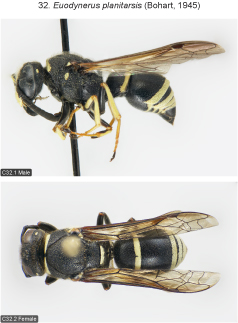
| Home | Table of contents | Keys | Species list | Glossary | Image data | PDF | Cite this article | Feedback | Updates |
Identification Atlas of the Vespidae (Hymenoptera, Aculeata) of the northeastern Nearctic region
CJAI 05, February 19, 2008
doi: 10.3752/cjai.2008.05
Matthias Buck, Stephen A. Marshall, and David K.B. Cheung
Department of Environmental Biology, University of Guelph, Guelph, Ontario, Canada N1G 2W1
Next species | Previous species | Key
32. Euodynerus planitarsis (Bohart, 1945)
Figs B5.11, 47; C32.1–4.

|

|
Species recognition. This species is very similar to E. leucomelas, from which it can be distinguished by the characters given in the key. An additional character, which is especially useful for identifying females, is the development of the costal scale. It is better developed, i.e., more convex in anteroventral view and with more acute edge in E. planitarsis than in E. leucomelas. The difference between the two species is very subtle, and requires comparative material.
Variation. Fore wing length 7–9.5 mm (♂♂), 9.5–10.5 mm (♀♀). Hind margin of tergum 2 usually at least slightly thicker than that of tergum 3 (thickening more pronounced in males than in females), width of thickening in some males up to 0.3x mid ocellar diameter. Female clypeus usually with a pair of dorsal spots, rarely confluent or absent. Scape black, usually with more or less extensive ill-defined pale mark beneath near apex, the mark usually dusky or somewhat reddish. Mesopleuron in female usually, in male sometimes with small or large pale dorsal spot. Female rarely with a pair of small pale spots on scutellum. Tegula marked with pale posteriorly and often anteriorly, the pale markings usually more reduced in male. Parategula marked with pale, the markings more reduced but rarely absent in male. At least metasomal terga 1–4 fasciate, in female usually also tergum 5 medially, in male tergum 5 always and middle of 6 frequently. Apical fascia of tergum 2 usually not extended forward on sides, the forward extension, if present, small and oblique. Female sternum 2 with complete apical fascia, sometimes with small interruption(s); sterna 3, 4 and rarely 5 with posteroapical pale spots; male sterna 2 and 3 with complete apical fascia, and sterna 4–6 with posteroapical pale spots, sometimes confluent and forming complete fascia on 4 and 5. Female mid and hind tibia with a dorsal ivory stripe extending over most of its length (rarely only half length); fore tibia with or without pale marking, if present often obscure or suffused with reddish.
One aberrant male from Dyers Bay, Bruce Co., Ontario, has large pale discal spots on sternum 2, which are connected to the apical fascia posterolaterally.
Distribution. Canada: NS to BC, newly recorded for SK, NT. Mostly northern U.S.: ME, NH, MI, WI, MN, CO (Bohart 1945, Krombein 1979).
Biology. Unrecorded. Fye (1965) described the biology of the closely related E. leucomelas (see above). Examination of his material (deposited at CNCI) revealed that his observations were actually based on a mixture of both E. leucomelas and E. planitarsis. Both species appear to have a very similar biology.
Next species | Previous species | Key
| Home | Table of contents | Keys | Species list | Glossary | Image data | PDF | Cite this article | Feedback | Updates |
